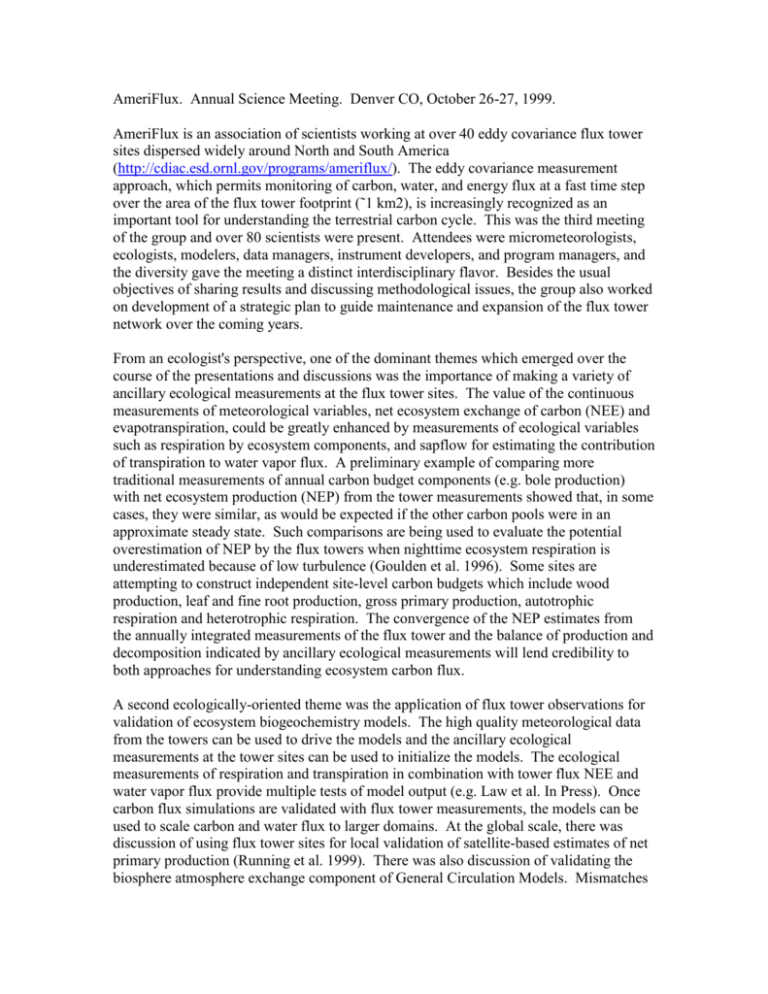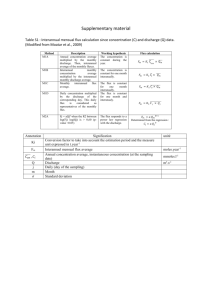AmeriFlux - Forest Science Labs
advertisement

AmeriFlux. Annual Science Meeting. Denver CO, October 26-27, 1999. AmeriFlux is an association of scientists working at over 40 eddy covariance flux tower sites dispersed widely around North and South America (http://cdiac.esd.ornl.gov/programs/ameriflux/). The eddy covariance measurement approach, which permits monitoring of carbon, water, and energy flux at a fast time step over the area of the flux tower footprint (˜1 km2), is increasingly recognized as an important tool for understanding the terrestrial carbon cycle. This was the third meeting of the group and over 80 scientists were present. Attendees were micrometeorologists, ecologists, modelers, data managers, instrument developers, and program managers, and the diversity gave the meeting a distinct interdisciplinary flavor. Besides the usual objectives of sharing results and discussing methodological issues, the group also worked on development of a strategic plan to guide maintenance and expansion of the flux tower network over the coming years. From an ecologist's perspective, one of the dominant themes which emerged over the course of the presentations and discussions was the importance of making a variety of ancillary ecological measurements at the flux tower sites. The value of the continuous measurements of meteorological variables, net ecosystem exchange of carbon (NEE) and evapotranspiration, could be greatly enhanced by measurements of ecological variables such as respiration by ecosystem components, and sapflow for estimating the contribution of transpiration to water vapor flux. A preliminary example of comparing more traditional measurements of annual carbon budget components (e.g. bole production) with net ecosystem production (NEP) from the tower measurements showed that, in some cases, they were similar, as would be expected if the other carbon pools were in an approximate steady state. Such comparisons are being used to evaluate the potential overestimation of NEP by the flux towers when nighttime ecosystem respiration is underestimated because of low turbulence (Goulden et al. 1996). Some sites are attempting to construct independent site-level carbon budgets which include wood production, leaf and fine root production, gross primary production, autotrophic respiration and heterotrophic respiration. The convergence of the NEP estimates from the annually integrated measurements of the flux tower and the balance of production and decomposition indicated by ancillary ecological measurements will lend credibility to both approaches for understanding ecosystem carbon flux. A second ecologically-oriented theme was the application of flux tower observations for validation of ecosystem biogeochemistry models. The high quality meteorological data from the towers can be used to drive the models and the ancillary ecological measurements at the tower sites can be used to initialize the models. The ecological measurements of respiration and transpiration in combination with tower flux NEE and water vapor flux provide multiple tests of model output (e.g. Law et al. In Press). Once carbon flux simulations are validated with flux tower measurements, the models can be used to scale carbon and water flux to larger domains. At the global scale, there was discussion of using flux tower sites for local validation of satellite-based estimates of net primary production (Running et al. 1999). There was also discussion of validating the biosphere atmosphere exchange component of General Circulation Models. Mismatches in spatial scale prevent direct comparisons over specific grid cells occupied by the towers, but the meteorological data and flux measurements can permit off-line, pointmode model validation studies. There were several presentations treating the linkage of flux tower measurements to large-scale carbon monitoring efforts based on inverse modeling. The inverse modeling approach uses spatial and temporal patterns in CO2 concentration from flask sampling, in combination with 3-D atmospheric transport models, to infer sources and sinks of carbon at the continental scale (Fan et al. 1998). High precision CO2 measurements at the flux tower sites could potentially be used to estimate the CO2 concentrations higher in the atmosphere, which would provide additional constraints for the inverse modeling studies. Considerable discussion at the meeting concerned the uncertainties associated with the large carbon sink in North American which has been suggested by the inverse modeling approach. Bridging the gap between the flux tower and inverse modeling approaches to carbon flux monitoring was identified as a priority for inclusion in the evolving strategic plan. Results of several synthesis efforts were reported and they highlighted the benefits (and difficulties) of assembling and juxtaposing meteorological and carbon flux data from a wide variety of environments. Even a simple cross-site relationship of NEP to mean annual temperature gave insights into large-scale geographic patterns in carbon flux. The fact that all of the sites in the synthesis efforts were carbon sinks on an annual basis suggests the need for additional sites which monitor flux on recently disturbed sites which in theory should be carbon sources. Overall, the presentations emphasized that flux towers are a remarkable new tool for monitoring ecosystem metabolism. The intensity and duration of ecological events, such as cavitation of xylem elements in response to severe drought, can now potentially be monitored in a way not previously possible. The interannual variability in production and decomposition for particular locations can now be closely followed and, with associated modeling efforts, that data will produce an improved ability to simulate the effects of climate variation on local biogeochemical cycles. There remain considerable technical challenges, notably with respect to nighttime fluxes, but flux towers are likely to play an increasingly important role in helping understand ecosystem behavior at the site level, as well as in validation of models used for scaling carbon and water fluxes to the continental and global domains. Interpreting the interannual and interdecadal variability in the global carbon budget is a major challenge to the global change research community. Monitoring the carbon cycle and the changes in the biosphere will also be critical in development of environmental policy to address global change issues. The kind of interdisciplinary science discussed at the AmeriFlux meeting will be critical in achieving these goals. Literature Cited Fan, S., -M., Gloor, M, Mahlman, J., Pacala, S., Sarmiento, J., Takahashi, T., Tans, P. 1998. A large terrestrial carbon sink in North America implied by atmospheric and oceanic carbon dioxide data and models. Science 282:442-446. Goulden, M.L., Munger, J.W., Fan, S., Daube, B.C. and Wofsy, S.C. 1996. Measurements of carbon sequestration by long-term eddy covariance: methods and a critical evaluation of accuracy. Global Change Biology 2:169-182. Law, B.E., R.H. Waring, P.M. Anthoni and J.D. Aber. Measurements of gross and net ecosystem productivity and water vapor exchange of a Pinus ponderosa ecosystem, and an evaluation of two generalized models. Global Change Biology, in press. Running, S.R., Baldocchi, D.D., Turner, D.P., Gower, S.T., Bakwin, P. S. and Hibbard, K.A. 1999. A global terrestrial monitoring network integrating tower fluxes, flask sampling, ecosystem modeling and EOS satellite data. Remote Sensing of Environment 70:108-128. David P. Turner Forest Science Department Oregon State University Corvallis OR 97331





